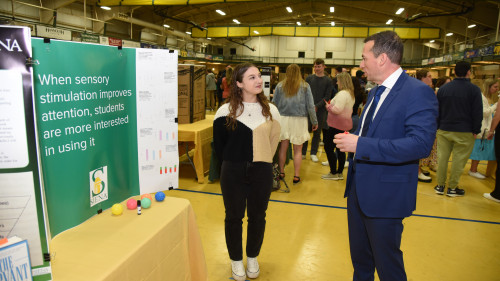

By Rebecca Davis ’15
While many people spend their summers trying to avoid bugs, Siena College environmental science major Nick McCloskey ’17 has spent his looking for them. Under the supervision of Assistant Professor of Environmental Studies and Sciences Mary Beth Kolozsvary, Ph.D., McCloskey observed macro invertebrates from local water supplies.
It was a perfect project for McCloskey who has always been interested in studying water. For the past two summers, he volunteered a citizen scientist in the New York State Department of Environmental Conservation’s division of water. McCloskey became involved in this research project last fall during a class he took with Kolozsvary and becoming a Siena College CURCA summer scholar allowed him to continue pursuing his passion.
“This has helped me focus my studies and narrow down job and grad school opportunities,” McCloskey said. “I’ve gotten to help out with just about every part of the project. I get to see the big picture and see how it can really help the community.”
The faculty-student team studied macro invertebrates because they are perfect for helping to determine water quality. Some, such as stoneflies, can only live in pristine water, while others, like leeches and isopods, are pollution tolerant. The presence of many pollution-sensitive macro invertebrates is a good indicator that the water is clean.
A watershed is an area where all of the water that runs through it drains to the same place. Siena College is located in the Kromma Kill watershed which drains into the Hudson River.
“We’re trying to get a better picture overall throughout the watershed of areas of pollution and where there are potential areas for restoration as well,” said Kolozsvary. “We’re very excited to be a part of this project.”
Once a month, from June until August, McCloskey and Kolozsvary collected macro invertebrates from different places in the watershed. They used a process called “kick-sampling,” where McCloskey did what looked like a twisting dance in the water to kick up sediments. Organisms then floated into a net for collection.
Then, in the lab, McCloskey determined the species of the macro invertebrates and used what is known as the “biotic index” to figure out if they are pollution-tolerant or intolerant. Though they can be seen with the naked eye, he used a microscope and camera to better examine them. Using a simple equation, he determined if the water they lived in was excellent, very good, fair or poor.
McCloskey will present the results of his summer research this November during the 11th Environmental Consortium of Colleges and Universities.
Click here to learn more about Siena's environmental studies and sciences program.

